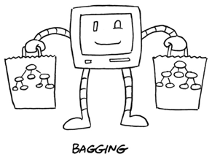When you start your neural network you want to assign random neural network weights to each node in the network.


In my previous articles What Are Machine Learning Algorithms and Choosing the Right Machine Learning Algorithm, I describe several commonly used machine learning algorithms and provide guidance for choosing the right one based on the desired use case and other factors.
However, you are not limited to using only one machine learning algorithm in a given application. You also have the option of combining machine learning algorithms through various techniques referred to collectively as ensemble modeling. One option is to combine the outcomes of two or more algorithms. Another option is to create different data samples, feed each data sample to a machine learning algorithm, and then combine the two outputs to make a final decision. In this post, I explain the three approaches to ensemble modeling — bagging, boosting, and stacking.
Bagging involves combining the outputs from two or more algorithms with the goal of improving the accuracy of the final output. Here's how it works:

The bagging approach results in reduction of variance, which in turn may improve the overall accuracy of the output in comparison to using a single tree.

Boosting involves one or more techniques to help algorithms accurately classify inputs that are difficult to classify correctly. One technique involves combining algorithms to increase their collective power. Another technique involves assigning the characteristics of challenging data objects greater weights or levels of importance. The process runs iteratively, so that the machine learns different classifiers by re-weighting the data such that the newer classifiers focus more on the characteristics of the data objects that were previously misclassified.
Like bagging, boosting results in reduction of variance, but boosting can be sensitive to outliers — inputs that lie outside the range of the other inputs. Adjusting for the outliers may actually reduce its accuracy.
Stacking involves using two or more different machine learning algorithms (or different versions of the same algorithm) and combining their outputs using another meta-learner to improve the classification accuracy.

The team that won the Netflix prize used a form of stacking called feature-weighted linear stacking. They created several different predictive models and then stacked them on top of each other. So you could stack K-nearest neighbor on top of Naïve Bayes. Each one might add just .01% more accuracy, but over time a small increase in accuracy can result in significant improvement. Some winners of this machine learning competition stacked 30 algorithms or more!
Think of ensemble modeling as the machine learning version of "Two heads are better than one." Each of the techniques I describe in this post involve combining two or more algorithms to increase the total accuracy of the model. You can also think of ensemble modeling as machine learning's way of adding brain cells — by strategically combining algorithms, you essentially raise the machine's IQ. Keep in mind, however, that you need to give careful thought to how you combine the algorithms. Otherwise, you may end up actually lowering the machine's prediction abilities.
When you start your neural network you want to assign random neural network weights to each node in the network.
Examples of machine learning applications that are designed to solve complex business challenges.
There are many different ways to use AI in business. See three examples of the use of artificial intelligence in business applications.